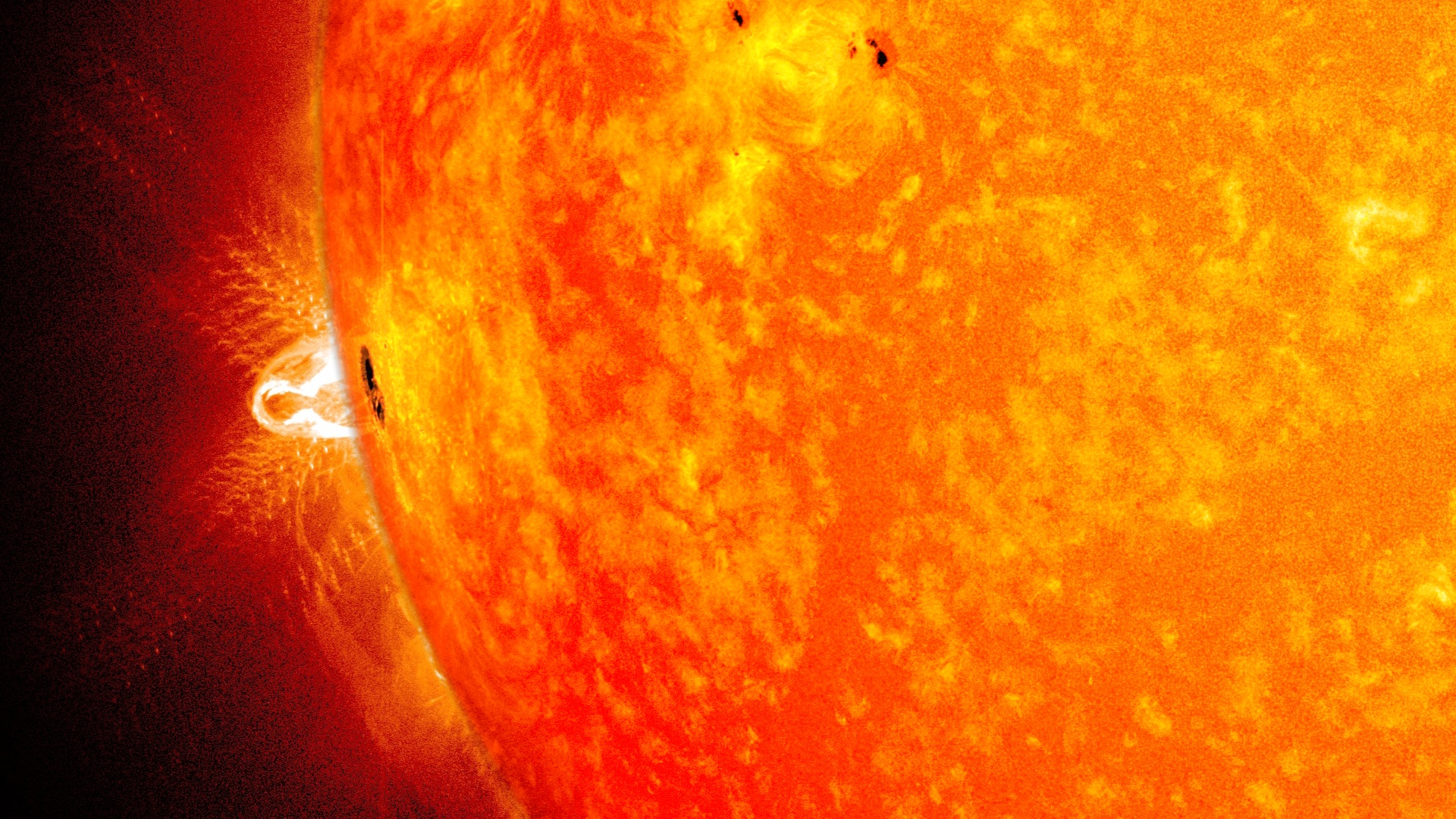NASA's SDO Provides Images of Significant Solar Flare
The sun emitted a significant solar flare, peaking at 7:49 p.m. EST on Feb. 24, 2014. NASA's Solar Dynamics Observatory, which keeps a constant watch on the sun, captured images of the event.
This flare is classified as an X4.9-class flare. X-class denotes the most intense flares, while the number provides more information about its strength. An X2 is twice as intense as an X1, an X3 is three times as intense, etc.
SDO footage of February 24, 2014 X4.9 flare in three wavelengths: 304, 171 and 1600 angstroms.
Credit: NASA/SDO
Watch this video on the NASA Goddard YouTube channel.

An X-class solar flare erupted on the left side of the sun on the evening of Feb. 24, 2014. This composite image, captured at 7:59 p.m. EST, shows the sun in ultraviolet light with wavelength of both 131 and 171 angstroms.
Credit: NASA/SDO

An X-class solar flare erupted on the left side of the sun on the evening of Feb. 24, 2014. This composite image, captured at 7:59 p.m. EST, shows the sun in ultraviolet light with wavelength of both 131 and 171 angstroms. Cropped
Credit: NASA/SDO

An X-class solar flare erupted on the left side of the sun on the evening of Feb. 24, 2014. This composite image, captured at 7:45 p.m. EST, shows the sun in ultraviolet light with wavelength of both 131 and 171 angstroms.
Credit: NASA/SDO

An X-class solar flare erupted on the left side of the sun on the evening of Feb. 24, 2014. This composite image, captured at 7:45 p.m. EST, shows the sun in ultraviolet light with wavelength of both 131 and 171 angstroms. Cropped.
Credit: NASA/SDO

These images from NASA's Solar Dynamics Observatory at 7:25 p.m. EST on Feb. 24, 2014, show the first moments of an X-class flare in different wavelengths of light – seen as the bright spot that appears on the left limb of the sun. Hot solar material can be seen hovering above the active region in the sun's atmosphere, the corona.
Credit: NASA/SDO

These images from NASA's Solar Dynamics Observatory at 7:25 p.m. EST on Feb. 24, 2014, show the first moments of an X-class flare in different wavelengths of light – seen as the bright spot that appears on the left limb of the sun. Hot solar material can be seen hovering above the active region in the sun's atmosphere, the corona. Unlabeled.
Credit: NASA/SDO

X 4.9 flare captured at 8:00 p.m. EST in 131 angstrom light.
Credit: NASA/SDO

X 4.9 flare captured at 8:00 p.m. EST in 131 angstrom light. Cropped.
Credit: NASA/SDO

X 4.9 flare captured at 7:59 p.m. EST in 304 angstrom light.
Credit: NASA/SDO

X 4.9 flare captured at 7:59 p.m. EST in 171 angstrom light.
Credit: NASA/SDO

X 4.9 flare captured at 7:58 p.m. EST in 193 angstrom light.
Credit: NASA/SDO

X 4.9 flare captured at 8:01 p.m. EST in 335 angstrom light.
Credit: NASA/SDO

X 4.9 flare captured at 8:02 p.m. EST in 335 angstrom light.
Credit: NASA/SDO

The early stages of the February 25, 2014 X 4.9 flare captured at 7:44 p.m. EST in 171 angstrom light.
Credit: NASA/SDO

The early stages of the February 24, 2014 X 4.9 flare captured at 7:45 p.m. EST in 131 angstrom light.
Credit: NASA/SDO

SOHO LASCO C2 Coronagraph view of the O-type CME associated with the X4.9 flare.
Credit: NASA&ESA/SOHO
For More Information
Credits
Please give credit for this item to:
NASA's Goddard Space Flight Center. However, individual images should be credited as indicated above.
-
Producer
- Scott Wiessinger (USRA)
-
Writer
- Karen Fox (ADNET Systems, Inc.)
Release date
This page was originally published on Tuesday, February 25, 2014.
This page was last updated on Wednesday, May 3, 2023 at 1:51 PM EDT.
Series
This page can be found in the following series:Tapes
The media on this page originally appeared on the following tapes:-
2014 Heliophysics Breaking News
(ID: 2014015)
Tuesday, December 30, 2014 at 5:00AM
Produced by - Robert Crippen (NASA)
